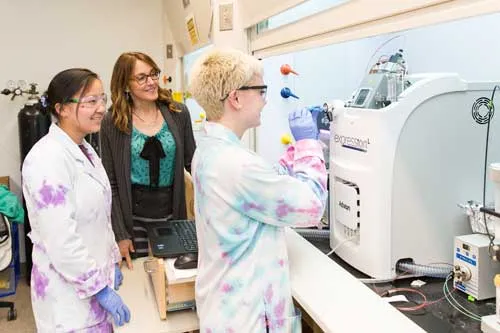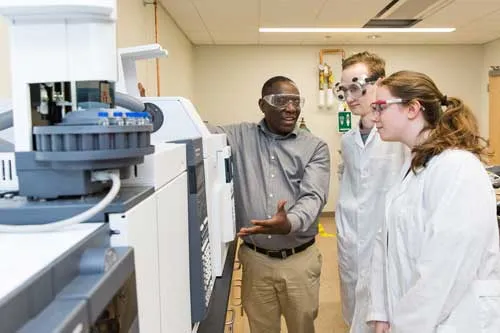Laboratories and Instruments
Chemistry and Biochemistry
Our facilities and instruments are designed for student and faculty research and classroom and laboratory teaching. All students who are properly trained may use our equipment, which is a highlight of our chemistry and biochemistry programs.
We have the same instrumentation capabilities you’re going to find at all the big universities. The difference is, at those universities only graduate students and postdoctoral researchers are allowed to lay their hands on those instruments. Here at Salve, we don’t have postdocs, we don’t have graduate students. So, our undergraduate students are free to conduct research and perform experiments using these instruments.
Dr. Bernard Munge, professor
Fast Protein Liquid Chromatography

Chromatography allows students to separate and purify protein mixtures using various columns, such as Q sepharose and gel filtration columns. Our students are focusing on a protein from Mycobacterium tuberculosis, the causative agent of tuberculosis, which infects nearly one-third of the world’s population and is responsible for the death of almost 2 million people annually.
Potentiostat/Galvanostat

The potentiostat/galvanostat allows students to conduct electrochemical kinetic measurements. As part of their applied investigations into renewable energy alternatives, our students are experimenting with electrolytes to determine which materials could be used to produce efficient, large-scale batteries.
Compact Mass Spectrometer

When students synthesize a new compound, they use the spectrometer to identify and characterize what they have discovered. With the threat of drug-resistant bacteria on the rise, our students are searching for compounds that will provide new leads in the development of anti-infective agents.
Gas Chromatograph/Mass Selective Detector

GC/MS is the analysis method of choice for smaller and volatile molecules such as benzenes, alcohols and aromatics, and simple molecules such as steroids, fatty acids and hormones. Applications include non-targeted screening of drugs of abuse, pesticides in foods, environmental pollutants and drug metabolites. The headspace accessory allows us to analyze volatile organic compounds in liquids and solid samples.
Additional state-of-the-art instruments include:
- Centrifuge
- Electrochemilluminescence
- Electron paramagnetic resonance spectrometer
- Flame atomic absorption spectrophotometer
- Flash chromatography
- Fluorimeter
- Fourier transformed infrared spectrometer
- Glove box
- High performance liquid chromatography
- Incubator/shaker
- Microwave digester
- Microwave synthesizer
- Nuclear magnetic resonance
- Quatz crystal microbalance
- Raman spectrometer
- Rotating ring disk electrode stations
- Rotary evaporator
- Screen printer
- Sonicator
- Speed vac
- Surface plasmon resonance spectrometer
- UV-vis spectrometer
- Water purification
- X-ray diffractometer
Students also have access to biology equipment such as the DNA sequencer and automated Western blot system.